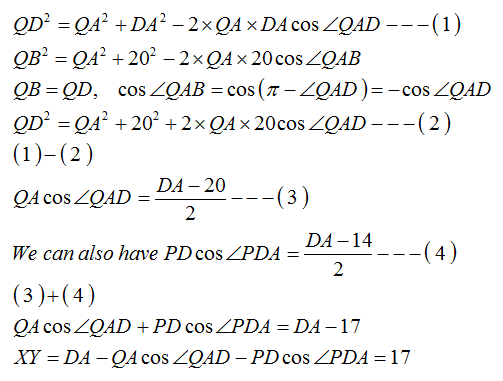Perps in a Cyclic Quad
Let be a cyclic quadrilateral with .
Let and be the points on major arc satisfying and .
Furthermore, let and be the feet of the perpendiculars from and to line .
If , , and , then find the length of .
The answer is 17.
This section requires Javascript.
You are seeing this because something didn't load right. We suggest you, (a) try
refreshing the page, (b) enabling javascript if it is disabled on your browser and,
finally, (c)
loading the
non-javascript version of this page
. We're sorry about the hassle.

Locate the point A ′ on line A D such that A ′ = A and A ′ Y = A Y .
Note that Q B = Q D by definition.
Also, ∠ A B Q = ∠ A D Q = ∠ A ′ D Q .
Angle chasing more, we see that
∠ Q A B = 1 8 0 ∘ − ∠ Q D B = 1 8 0 ∘ − ∠ Q B D = 1 8 0 ∘ − ∠ Q A D = 1 8 0 ∘ − ∠ Q A ′ A = ∠ Q A ′ D
Thus, △ Q A B ∼ △ Q A ′ D by AA-similarity. However, Q B = Q D so actually △ Q A B ≅ △ Q A ′ D .
Thus, A B = A ′ D . Thus D Y = A ′ D + A ′ Y = A B + A Y
Similarly for the other side, we get that A X = C D + D X
Summing these two equations together, we get A X + D Y = A B + C D + A Y + D X
but A X = A Y + X Y and D Y = D X + X Y so the equation simplifies after cancellation into 2 X Y = A B + C D
Plugging in values we know, X Y = 2 2 0 + 1 4 = 1 7 and we're done. □
Note the Red Herrings in this problem: